#apparently this was inspired by an art installation/exhibit
Photo

Books of 2023. THE EMPLOYEES by Olga Ravn. This was a very weird, very poetic, reasonably fucked up little book that I’ve had my eye on since it was released in English, and I enjoyed it! It’s one of those hugely ambiguous, “good luck sorting this shit out” type books, told in statements by the human and humanoid coworkers on a space ship (and there are alien artifacts involved).
#books of 2023#books#book photography#the employees#olga ravn#i found a review that linked to a lot of background stuff#(on goodreads i mean)#apparently this was inspired by an art installation/exhibit#i didn't look into it Much but i definitely scrolled through some gallery pictures (without reading the placards or anything) and that uh..#clarified some shit lol#anyway definitely a trip i enjoyed it and it went very fast!!#the hardback edition has teeny tiny pages and text though#(that's the edition i read)#i'm not sure if paperback is much better
16 notes
·
View notes
Text
So I know I posted a thing about Dreamling approximately 1252 months ago and then never did anything but I opened the google doc today and instead of doing anything on that I was immediately hit by the idea of gallerygirl!Dream
(Sources for this AU - me and continued career as a gallery girl, or as my mother called me a 'girl Friday', which made me sound like a prostitute but is apparently a Cary Grant film)
Anyway, I think Dream would make an amazing gallery girl. What else do pale goths with dramatic fashion tastes and who listen to way too much joy division do other than sit behind a desk and imperiously ignore rich people? Of course, he would secretly own the gallery because in addition to being a pathetic arts grad he is also a trust fund baby, but he's not telling that to the sexy art handler who comes in to install the gallery's very intermittent exhibitions.
The first time Hob entered the gallery, he immediately turned to Dream, who was doing peak gallery girl you-can't-afford-anything here-so-just-leave impression behind his desk in his ergonomic desk chair, and pointed out the marble statue he was moving looked both like a penis and a very peurile take on Louise Bourgeois. He then picked it up entirely by himself and the experience of seeing his biceps made Dream instantly forgive him for everything and totally forget about how much the insurance on the hideous sculpture was (if any, any of his employees mention that they suddenly start doing a lot more sculpture shows, Dream will personally end them.)
Anyway, no plans as yet, but if this inspires anyone else please do let me know, I want to read this without having to make the effort of writing it lol
#dreamling#gallerygirl!au#hob gadling#dream of the endless#the sandman#Listen I work in galleries and it really is hell I need an outlet
40 notes
·
View notes
Text
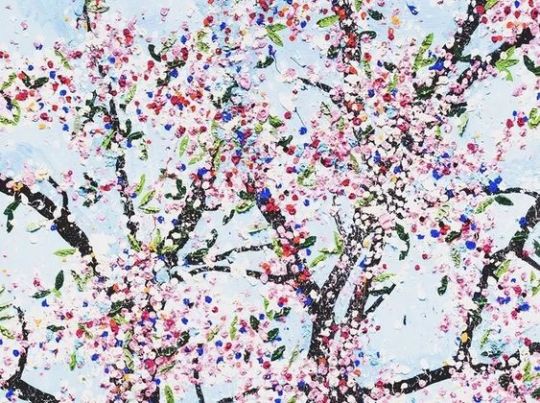
discover and collect art from Damien Hirst’s iconic The Virtues series
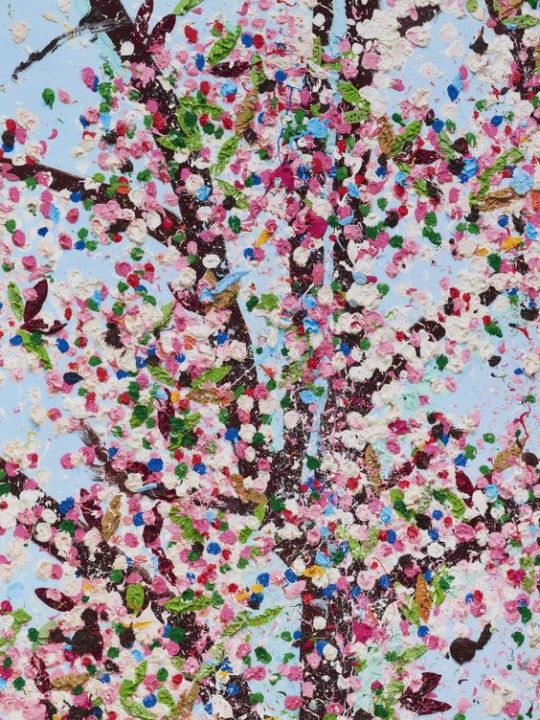
A celebratory depiction of blossoming cherry trees, Damien Hirst’s H9 The Virtues was inspired by trees remembered from his Devonshire childhood. As Japan’s national flower, the blossom also symbolises the Japanese values used to title the eight giclée prints: justice, courage, mercy, politeness, honesty, honour, loyalty, and control.
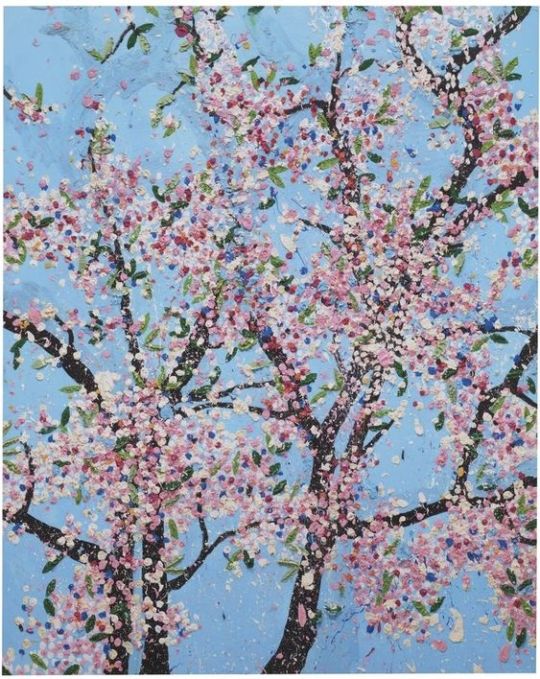
DAMIEN HIRST Politeness

Fondation Cartier is slowly turning out to be one of my regular addresses during trips to the City of Light. I also visited an exhibition there last summer. I think this art museum has many assets. The building that houses the museum is architecturally quite interesting. It is constructed with a lot of steel and glass. At the back, the elevator on the outside of the building goes transparently to the higher floors, which you as a visitor to the museum cannot reach because there are offices there. The exhibition space is located on the ground floor and is bathed in daylight. Ideal for displaying art. The ceilings are high, the space is large and - not unimportant in corona times - this means there is never any crowding. The exhibition space continues to the basement. The building is located in a beautiful garden that is closed off from the hustle and bustle of the city on the street side by a large glass wall. For me, a visit to an exhibition in Fondation Cartier always includes a walk through this garden, followed by a drink on the terrace under the trees behind the building. When I enter the museum grounds through the gate around the garden, I am always full of admiration for the gigantic cedar that stands there. But this time it was an unpleasant surprise: the tree had disappeared and the remains of its huge trunk were scattered in pieces in the garden. I really hope that the tree was sick and there really was no choice but to cut it down. This time the exhibition space was taken up by large, colorful works by Damien Hirst. Not being a real art connoisseur, this name still rang a bell with me, but I honestly still don't know why. I know the name from somewhere, but I haven't been able to identify where yet. While Googling, I discovered a versatile artist: he makes installations and sculptures, but also paints and draws. Apparently (or so I read) his works regularly cause "unrest" and he is considered one of the most important contemporary artists. Through Google I discovered works with preserved animals including a shark and a golden calf, counterfeit supposedly unearthed treasures from sunken ships, a skull full of diamonds, … and all with long, apparently unrelated titles. To be honest, I couldn't/couldn't quite reconcile all that with the works that I saw exhibited in Fondation Cartier. The exhibition spaces were full of large works with cherry blossoms in fresh colors. The blossoms depicted by thick blobs of paint. The use of color and theme reminded me of Van Gogh's almond blossoms. So nothing controversial or disturbing. The paintings on display in Paris are a small selection of a collection of 107 paintings with the same theme. They are exhibited together for the first and last time because they will all end up in different places. In that sense, and also given that it is the first time that this artist has exhibited in Paris, this exhibition is unique. But although the works may be beautiful and fresh and fruity, I must be honest and say that for me they are all too similar to be able to speak of a truly fascinating exhibition. Do you want to go there too? That's still possible
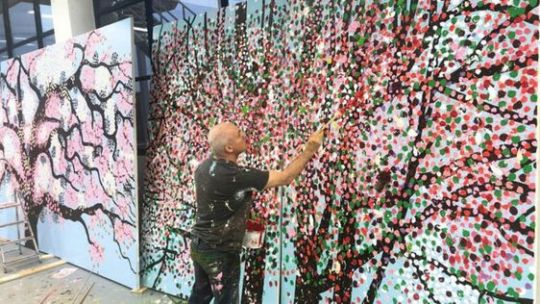
l'artiste
12 notes
·
View notes
Text
Climate Action
‘It is not about the medium, it is about what you are trying to say’
Inspired by the above quote from Louise Bourgeois, Still Moving is the collaborative effort of Leonie Hampton, Laura Hopes and Martin Hampton combining their respective disciplines of photography, research, filmmaking and architecture in a more ambitious direction. Exhibiting across the UK and in Egypt the group creates light installations on in response to climate change and in particular targets COP Summits with thought-provoking slogans and symbolism.
In recent works the group has used Ben Okri’s poem ‚LOVE IS THE HIGHEST ECONOMY OF LIFE’ in response to the climate emergency, which was displayed on loop across Plymouth’s Civic Centre.
The workshop provided by Laura Hopes introduced the fundamentals of the practice: the mechanics and wiring of the light grids and the construction and composition of the letters. Inspired by the work of the collective, two slogans competed to be displayed in the studio entrance: Use Your Power vs. Soup Won’t Work. Despite not being chosen, Soup Won’t Work was better suited to the overall motive of Still Moving, as a direct criticism to Just Stop Oil’s provocative yet fruitless attempts at militant action to bring light to the climate crisis – specifically the incident of throwing soup at Van Gogh’s Sunflower’s in the London National Gallery. While soliciting national attention and publicizing the Just Stop Oil movement it was of no productive value to the cause of climate change itself.
Laura’s workshop was one of the most engaging of the module both practically and thematically – engaging both aesthetics of architecture and installation, and skills of debate, reasoning and politics. Politics is intrinsic to art; expression isn’t confined to the limits of emotions and skills – personal values will always become apparent if not through subject matter then through process or exhibition.
With regard to political engagement, I have been active with the Palestine Solidarity Campaign throughout the course. Though a humanitarian crisis foremost, the 100 day mark of the genocide has established an equally disturbing environmental cost to the conflict – if the human has not been enough – emitting 281,000 metric tons of CO2 since its beginning. Engagement with the Palestine Solidarity Campaign has channeled the theme of anger into something more vital and constructive. I will not attempt to compromise protest to being a medium or a form of self expression – I will not spit in the face of struggle – however through my activity I have developed a deeper understanding of the concept of anger as rigor mortis.
0 notes
Text
Final Major Project "scale"
Changing the scale of an object determines how it's perceived.
when originally thinking about my Final major project started by thinking about random objects that bring me joy for no apparent reason and tried to analyse why that may be. One of those things included miniature replicas of existing objects which brought me to the idea of scale an how important scale is in how you perceive it. I tried to think about why it may be that I enjoy and feel satisfaction from small objects but I couldn't pin down one rational answer, but I know many people share this opinion. I know its a popular opinion in children too as many children toys including some I remember having where miniature objects like mini brands and Squinkies. I also remember being way more excited about the mini baby bottles, shoes and food than I was about the barbies or sylvanians themselves. I also started thinking about objects scaled up as I always notice public installation of objects sized up for example in Trafalgar Square the large ice cream instillation with a cherry, drone and fly on it and the spoon and cherry in the Minneapolis Sculpture Park. This idea of thinking about any object completely changing its value made me think about functioning objects that have multiple sizes and each scale having its own reputation. For example doors, tall doors have the reputation of being expensive and luxurious, however noticeably small doors have some sort of intrigue about them and for me make me think something mystical must be behind it. There are also generalisations attached to size on things like jewellery where small can be seen as dainty and pretty and chunky can be seen as loud and tacky, however in high class the bigger the better. Also in clothing scale and fit is important, when clothes are larger and more baggy by the younger generation it’s seen as cool and trendy but by the older generations it's seen as scruffy. Scale can also be important in terms of scale drawings and models when presenting ideas. Architects use scale models to share ideas in a three dimensional way without spending too much money and time. There are many more examples of how scale can be used to change an object and I intend on exploring these over the next eight weeks. I am excited to begin this project as I want to create material texts and attempt to use new techniques such as working with ceramics and the metal workshop, as well as possibly making miniature/ ginormous replicas of objects. I aim to work in high detail and I am excited to see my standard of work increase.

In my final major project I intend to explore scale in order to understand why the scale of something is such an integral part of its existence as well as seeing how changing an object's scale can change its value and perception. I also intend on looking at archetypal objects size and what happens when the scale is changed drastically as well as only slightly. To start this project I will do extensive research into different designers that are known for playing with size in their work, I will also look into exhibitions and public installations related to design and scale. I will also carry out interviews and surveys to get primary research to give my project a more personal feel. I will look into Claes Oldenburg, a Swedish sculptor based in America who was best known for his public installations of scaled up everyday objects. Oldenburg was inspired by the elements of street life, including store windows, graffiti, advertisements and trash and by scaling up these objects in a public place drawing more attention to them. I will also look into Tatsuya Tanaka who is a Japanese art director and photographer who created miniature dioramas often adding mini figures to regular sized objects to make it look like something else, for example a face mask becoming a swimming pool. Alongside researching designers and artists who use scale to inspire art, I also aim to look at movies/ documentaries and hopefully exhibitions and museums, i have been looking for museums and exhibitions I could see that would relate but unfortunately all the ones I found, including The Museum Of Miniatures and Small is Beautiful, have been closed since september or are in other countries. I have however been looking at legoland and all the miniatures they have there. I am also interested in window displays which often include props of objects which have been scaled up. I am also interested in props that are made for animations where they create another world all scaled down by 10-20. I find the level of detail put into miniature props so inspiring and interesting to look at. As most people who work with challenging scale tend to be artists and sculptors I think looking at this subject from a design perspective will change how it’s looked at and the reason for design choices.
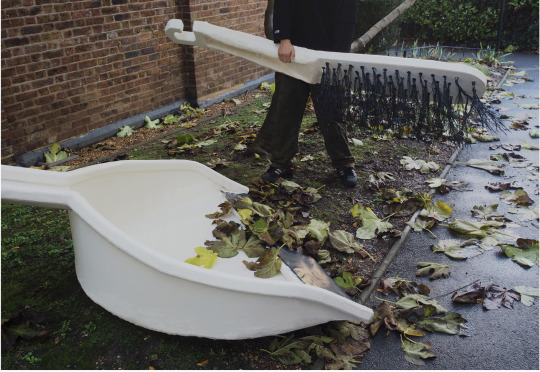
I chose this direction as thinking back on my projects, my favourite outcome was the big clean brief where we scaled up a dustpan by 7x. This gave the dustpan much more value and allowed people as well as myself to show interest in an object I would otherwise not care about. I also found the walk this way project inspiring as we made scale models to display our ideas. The best parts for me about this project were the making process and trying to take photos of it after that made it look life sized. I also noticed in the What Now project almost everyone brought in a tiny object/ toy/ souvenir as their sentimental object, I did too, which make me think about why smaller objects have greater value. However, I think all of the projects we have completed have had elements of them which improve how I think, make, research and generate ideas.

Looking at different cultures that look at size, I instantly thought about Mayan worry dolls, The story of the worry dolls is a Mayan legend about a princess named Ixmucane, who received the gift of a worry doll from the sun god that would solve all her problems. When i was younger my mum gave me a notebook with mayan dolls and said to write my worries in it and something about these tiny dolls around 2 cm tall, as well as they have the same name as me made me very attached to them. There are also lots of cultural buildings that are celebrated for their size, for example the Taj Mahal and the Pyramids of Giza. Where people often say you won't understand the scale until you see them in person. I wonder if these buildings would be so famous if they were 10 times smaller. I will also look deeper into cultural references to do with scale, for example giants and fairies snd how some people believe the Egyptians were giants which is why they were able to make their pyramids so large without modern tools and equipment.
0 notes
Text
KMSKA Antwerpen fails to put together a coherent museum
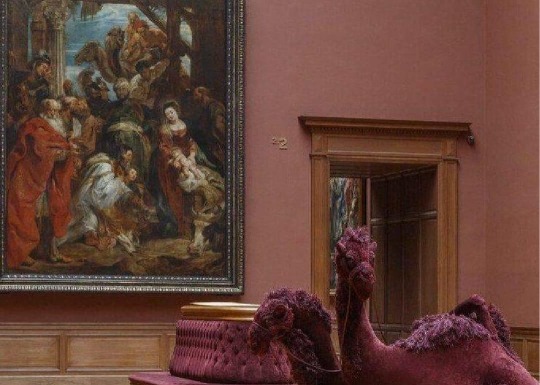
In this essay I want to argue that the KMSKA fails in properly connecting the maker, the exhibitor and the viewer in the way described by Michael Baxandall in his essay ‘Exhibiting Intention: Some Preconditions of the Visual Display of Culturally Purposeful Objects’. This essay is mostly about anthropological exhibitions, but is also very applicable to the KMSKA. I also want to prove that the museum mostly focuses on the museum effect, a term coined by Svetlana Alpers in her essay ‘The Museum as a Way of Seeing’.
The first thing you notice when you enter the KMSKA is the monumental architecture. Outside you have the very classical structure reminiscent of the old Greek and Roman temples, whereas inside you are greeted with blinding white walls and floors. The KMSKA pride themselves on the intersection of old and new architecture in the different collection rooms. They also named their own staircase the ‘Stairway to Heaven’, as it is fully white and seemingly goes on until high up in the sky.
Another part of the museum that creates a long waiting line is an installation called ‘2 Conflict Paintings + Colour Method in 7 Layers’ by Boy + Eric Stappaerts. The KMSKA itself describes this long passageway (that falls right under the stairway to heaven) as a “tsunami of colours”[2]. At the end of the passageway there’s an archive of colours fitted into a cabinet, as a sort of display of colour.
The old masters part of the museum has a big empty room where projections inspired by details of paintings get shown on the walls, and seem to move around you. It was extremely disappointing that one of their projectors apparently is already broken, as a pretty big part of the wall did not have any projections on it, but the video did seem to move on to that piece of wall. It gave off the feeling that they had a room that they couldn’t adequately fill with artwork, so they decided to make it an installment.
In this way, it almost feels like the KMSKA is mainly focusing on photo opportunities to gain some free advertising on Instagram, than it is on actually creating fine museal architecture. The stairs, projection- and rainbow room get almost more attention than the artworks themselves, because they make it easier for the visitors to take an Instagram worthy picture.
The KMSKA prides themselves on their James Ensor collection, even going as far as giving the artist a few rooms all to himself. These rooms were accompanied by small ‘chambers’ where his sketches were exhibited. The Ensor exhibition raised a few questions, but the two most important ones will be discussed below.
The first is, if this part of the museum is a part you are so proud of, then why did you make the chambers so small and the pathways so annoying to follow? There were so many people inside these rooms, as it is also the logical first part of the museum to enter. This is, of course, not inherent an issue of the KSMKA, but more of too many people wanting to see the same thing, but I do feel like the display could have been different and helped somewhat. The chambers are divided into little corners where two walls are used by two television screens, but as you barely have any space to relax and read the information on the screens, it was almost useless. At the end of the Ensor labyrinth, we get a few big white halls, which are way better to appreciate the art in peace. But why was there a random freestanding wall in this room, with nothing on the back and nothing behind it? I can get doing that to make the room feel smaller than it actually is, but this wall was placed on the longest side, and didn’t even span the whole width.
My second Ensor related question is, why is some of his art exhibited among the old masters? Since when is this symbolist painter a master of old art? He was not the only one who was exhibited in the wrong time period, as the KMSKA does divide their museum in modern and old masters, but throws art of both divisions in both sections. A Bruegel was happily lounging next to a painting by Theo Van Rysselberghe. A Basquiat was put right in the middle of a few 17th century busts. The non-chronological display of paintings has been an upcoming trend in many museums, and I can understand curators choosing this approach – going for a theme instead, for example. But if you explicitly divide your building in old and modern masters, perhaps don’t mix them around inside the exhibition rooms, it just makes it look like you don’t really know what you’re doing.
And thus, a lot of this museum remains a mystery for the viewer. Why did they put these things together? Why is there an Ensor next to an old master? And – I’m never going to let this go - please explain to me why there is a camel made out of a sofa.
[1] Svetlana Alpers, The museum as a way of seeing, 26
[2] ‘With the support of the National Lottery | KMSKA’, geraadpleegd 20 december 2022, https://kmska.be/en/support-national-lottery.
[3] Baxandall, Exhibiting intention. Some preconditions of the visual display of culturally purposeful objects, 39
[4] Baxandall, Exhibiting intention, 37
0 notes
Text
Virtual spades and voices
Apart from the spaces mentioned above, there are a number of other organizations that are creating opportunities for projects that connect literature/art and ecology, as well as artists from other disciplines that are creating similar projects. This is a non-exhaustive list of what we have found so far:
Tolhuistuin in Amsterdam hosts a project to change the North of Amsterdam into an ecozone with the help of art, as well as the Warming up festival.
Arnhem museum (exhibition 'Best before', about the question whether art can change how people connect with the earth).
Wevelgem Climate Festival that hosts, among others, lectures and poetry walks by Klimaatdichters.
Horror Garden, Gosie Vervloessem's investigative workshop about the relationship between humans and plants.
RIZOOM, a nomadic artwork in search of a more embodied vision of ourselves in the world (
The Embassy of the North Sea was founded on the principle that the North Sea owns itself. Here, the voices of plants, animals, microbes, and people in and around the North Sea are listened to and involved.
Stichting Nieuwe Helden (Company New Heroes) usesmultidisciplinary storytelling to spark the imagination and to inspire and drive practical ethical conversations. Their Nature Building Project offers an interactive and experiential way to get people of all ages and backgrounds to building a greener world for everyone.
Collectief Walden (Walden Collective) creates interdisciplinary projects, installations, performances and spaces dealing with the urgency of the ecological crisis, where science, visual arts and documentaries are interspersed with poetry, mime and other art forms. An example is the RADIX audiowalk 'Stoepplantjes' ('Pavement plants') that explores the way we deal with so-called 'invasive species', taking the infamous Japanese knotweed as an example.
Dichter bij de polder (Dutch pun on the double meaning of Dichter: Closer to the polder/Poet in the polder) is a poetic bicycle route through the Alblasserwaard. 11 poets have chosen a specific spot to write a poem about. The project was initiated by Lions Alblasserwaard to have visitors look at the landscape through the eyes of the poets.
Remembrance Day for Lost Species, November 30th, is a chance each year to explore the stories of species, cultures, lifeways and habitats driven extinct by unjust power structures and exploitation, past and ongoing.
Climavore: On Tidal Zones explores the environmental impact of intensive salmon aquaculture and reacts to the changing shores of Portree, Isle of Skye. Each day at high tide, the installation works as an underwater multispecies oyster table.
On Sonorous Seas gives voice to what is not apparent beneath the beauty of the Hebridean waters. Through art, music and poetry, On Sonorous Seas encourages a deeper listening to, andunderstanding of the sounds we may find there, and their meaning for the ecology of our seas.
Vibeke Mascini, Doodsreutel, a performative art work to reanimate a single word—doodsreutel (death rattle) and to return it to the Van Dale (main Dutch dictionary).
Aliki van der Kruijs, Made by Rain, a textile register of rain fall at a specific location. It is an ongoing investigation into the effect of weather phenomena on daily life and is a self-initiated project.
Artists collective Satellietgroep (founded by Jacqueline Heereman in 2006) explores the reciprocal relations of humanity and nature, with a focus on the sea, (coastal) landscape transitions, climate and the impact of humanity on the world, in the Netherlands and abroad.
Artists from other disciplines
Of course, artists from other disciplines are also engaged in topics around art and ecology. A few well-known examples are textile artist Claudy Jongstra, visual artist Herman de Vries, who uses nature as art to say something about the disturbed relation between man and nature, conceptual artist Tinkebell, for example her houseplant project, and visual artist Babette Wagenvoort (for example, the Not in my backyard wall drawing about extinct species), among others. We received a lot of examples from the theatre world, which we have collected under the heading below.
Theatre
Maria Lucia Cruz Corea, artist in residence at art centre De Vooruit in Ghent, combines art and science in her work, for example in her workshops about climate grief, collective human trauma caused by the loss of ecosystems, in which language plays a pivotal role.
Rebekka de Wit and Anoek Nuyens, Tenzij je een beter plan hebt(2017): a theatre text about the growing call to reform the relationship between humans, animals, nature and things.
Luanda Casella, Ferox Tempus, that shows the terror of climate destruction.
Kyoko Scholiers, Zone X, a fictive guided tour in the year 2124, in an area that has been isolated from the world after disasterstruck in 2034.
Ontroerend Goed, World without us. See the interview with Mahlu Mertens for a description.
Laika / Sien Vanmaele, Zeemaal. A sensory, connecting dining experience departing from the sea, Zeemaal ('sea meal') is the first part of a trilogy about Sien's extensive research into sustainable culinary answers to climate change
Dying Together/Earth, inclusive theatre performances by Lotte van den Berg about the dying out of species.
You can find an ever-growing collection of climate poetry and other texts on the Klimaatdichters website.
0 notes
Text
On Felix Gonzales Torres
This artist talk came at a surprisingly timely moment for me. I had just been to the Art Institute of Chicago in late September, and saw Felix Gonzales Torres’ “Untitled” candy piece. I had vaguely heard about this installation in art history books, but when I walked in the room in Chicago I was immediately fascinated by the pile of vibrant candies. Without knowing the context at all, I was instantly transported to when I was a kid and would dump out all my Halloween candy on the floor out of a pillowcase. I read the statement and was taken aback at what this was signifying for the artists—the number of pounds of Torre’s partner, Ross Laycock, who died of complications of AIDs in 19991. What I saw as purely playful and trolling high-art in a sense, became somber, deep, and reflective. I had taken a piece without knowing and still had the overly sweet industrial lime flavor in my mouth. But notably, the Chicago Art Institute didn’t have all the information about the piece and was critiqued on Twitter that same weekend, which apparently has happened before because Torre’s estate doesn’t specifically tell galleries what to write about the piece, Torre’s only says that the weight should stay around 175 pounds and that the gallery can’t tell the audience that they can or can’t take a piece of candy.
That said, this week we watched the artist talk of Elena Filipovic, a curator from Berlin says she made the retrospective of Felix Gonzales Torres work with about 50 artworks, then she asked other artists to change/evolve her show. Some picked totally different works and it was interesting to see the vast number of ways people get inspired by the same artist.
Here are a few notable moments and questions I pulled from the video:
Secrets. The unspoken ‘rules’ of the gallery world. A sort of constitution is involved. Today it’s all about using available materials, otherwise, it's considered a bit fetish to go over the top with new stuff.
For example, some types of light bulbs are no longer legal in the EU, so what do you do when an artist used those back in the 80s-90s and now they can’t?
Conservation rooms next to contemporary art spaces
Materials on view in a different room:
“In a state of repose”
which
“Elongates the event”
What happens before the art goes into the gallery and after?
Does a sculpture in storage space make it no longer a sculpture?
What do you do with artworks that are given out in a gallery for free?
Should I keep it, throw it away, or frame it? It’s a little crumpled…
White cardboard 12-point font times new roman, neutral default.
Question the little things in an exhibition…
Challenge of timelessness. The curator says no it was made in time, with imagined and real structures
A retrospective is not just paying tribute to someone or imagining what they would’ve wanted, it’s not just about pleasing somebody. Make it alive, done, and undone.
https://www.youtube.com/watch?v=mLjMoo6dV_g
1 note
·
View note
Photo
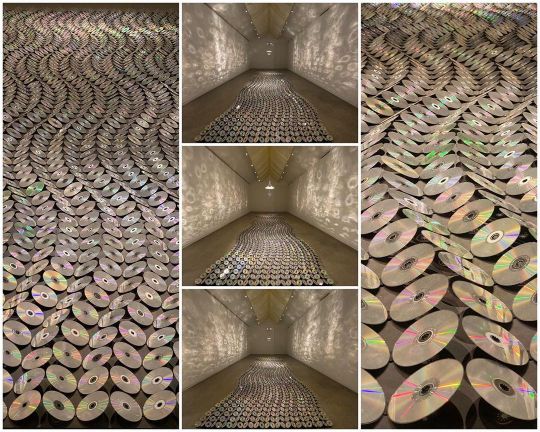
The big exhibition at #Heide is by British artist Bruce Munro ‘From Sunrise Road’, many inspired by his time in Australia including the suburbs of Sydney and Uluru. A light installation in the park is apparently super at night! (at Heide Museum of Modern Art) https://www.instagram.com/p/ChyIMQ2vEa_/?igshid=NGJjMDIxMWI=
0 notes
Note
i see artist!reader AUs but never any w someone who works at a museum or gallery, like in curation, education (my dept lol), preparators (those who actually install the artwork), etc. Maybe Timmy is invited as a plus one to a member preview/opening for a new exhibition at a museum, gallery, or art fair and meets the reader? Any faceclaim works. Set in LA or NY, maybe LA winkwink, but art really is everywhere and not just in NY!! (Local programs and centers are Amazing 😌)
A/N: HIII omg im sry this is soooo long overdueee but here it is :)) i hope this comes up to ur expectation but if not im sorry i hope u still enjoy this :p serving my tiny knowledge ab art exhibitions and stuff TY FOR GIVING THIS INSPO LOVE
lacma
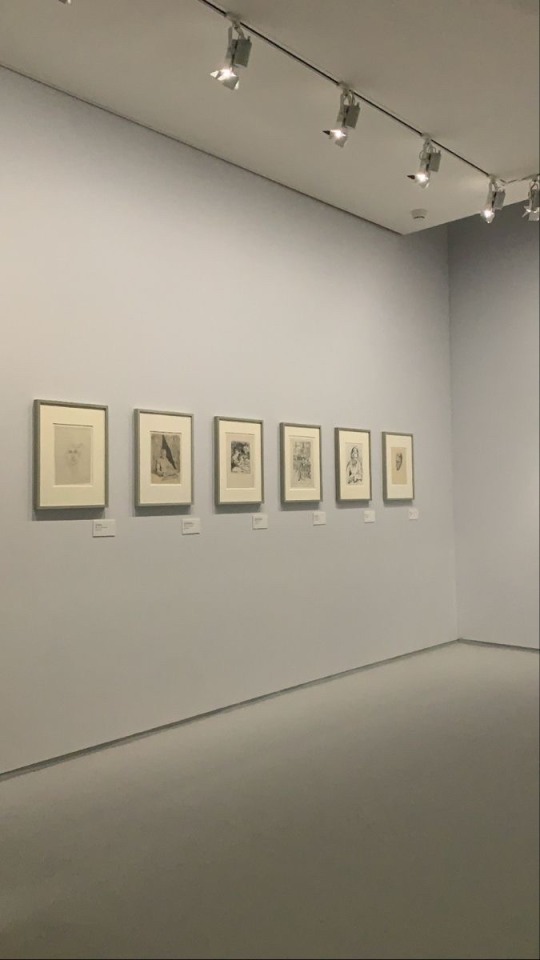


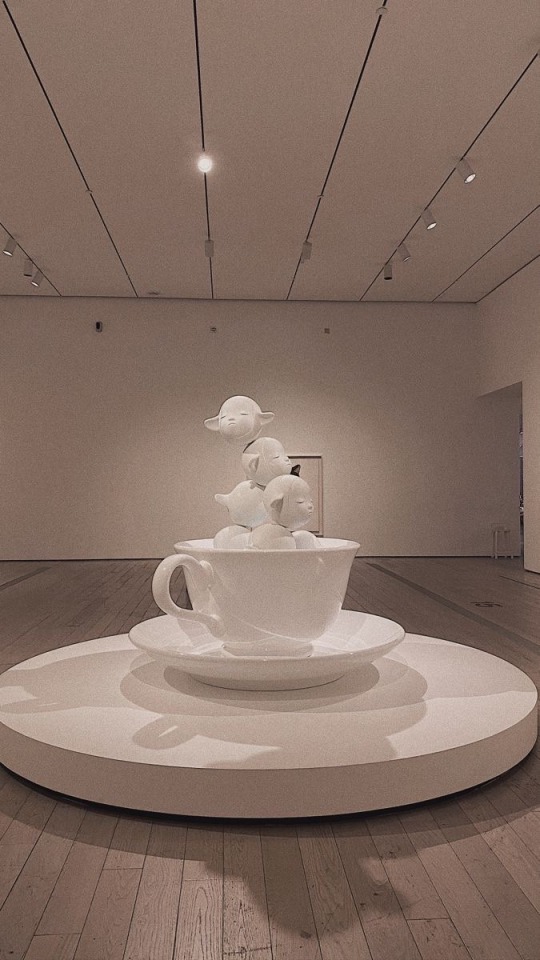
Liked by y/i/n and 2.910 others
lacma “y/n l/n has a way with addressing important matters. big, bold, often visually grand art pieces.” l/n mixes exceptional sculpting skills with deep knowledge of the structural complexities of art, human, and nature. our member’s exhibition “y/n l/n: a manmade nature,” will be on view at lacma starting this friday, april 1 - april 30. treat yourself and rsvp for the opening ticket at the link in our bio.
See all comments
y/i/n can’t wait!! thank you lacma for this opportunity❤️
fanpage28 OKAAAYYY MISS GIRL FINALLY GETTING HER RECOGNITION
fanpage28 OKAAAYYY MISS GIRL FINALLY GETTING HER RECOGNITION
fanpage17 EEEE SO EXCITED JUST RSVP’ED MY TICKET FOR FRIDAY
fanpage18 am i flying to la just for this? yes
↪️ y/i/n wow!!! thank you so much for ur support 🥰 excited to meet you!!!
↪️ fanpage18 I LOVE YOU OFC IM SUPPORTING YOU ❤️❤️❤️❤️❤️😭😭😭
fanpage39 so excitedddd aaaah
fanpage88 MY MUSE
fanpage67 i made a painting inspired from y/n’s unique standpoint of life check it on my page😊
fanpage95 from installing arts to being the art herself, y/n everybody!
*Liked by @y/i/n
y/i/n


Liked by tchalamet, lilyjcollins and 893.338 others
y/i/n OPENING DAY!! still cant believe this is happening!! im so relieved all of my visions, tears, sweat, and blood are now paid off. i hope through these sentimental pieces, i can deliver my emotions and raise awareness of the importance of revitalizing the nature for the sake of the human race while taking care of the old planet we’re living in. with the help of an amazing support team, i can proudly say we’ve successfully realized this event ❤️
See all comments
opheliamillaiss my sweetheart 🖤 ti amo
fanpage29 im so proud of you i remember those days when you’d just make little sculptures and post it on insta
fanpage40 im so proud to say ive grown up with you y/n❤️❤️❤️❤️❤️
oliviarodrigo SLAY MAMAAAA
↪️ y/i/n THANK YOU FOR COMING SMOOCHIE😘
fanpage39 YASSS FINALLY
tchalamet it was magical
↪️ y/i/n as you are <3
fanpage18 HEEEY WHAT? TIMOTHEE?
fanpage44 apparently.. timmy was y/n’s plus one..
fanpage28 when did timmy and y/n???
lilyjcollins wish i could attend but im so so so proud of you sis! ❤️❤️❤️
↪️ y/i/n thank you for the love lils miss ya!
fanpage50 SOOOO is timothee.. one of y/n’s muse???
devonleecarlson she used to intern at lacma and look at her now! 😭😭😭 shes now the moment!!!
fanpage99 shes truly something😭😭😭😭✨✨✨
fanpage87 another day another slay! PERIOOOOOD!!!!
tchalamet
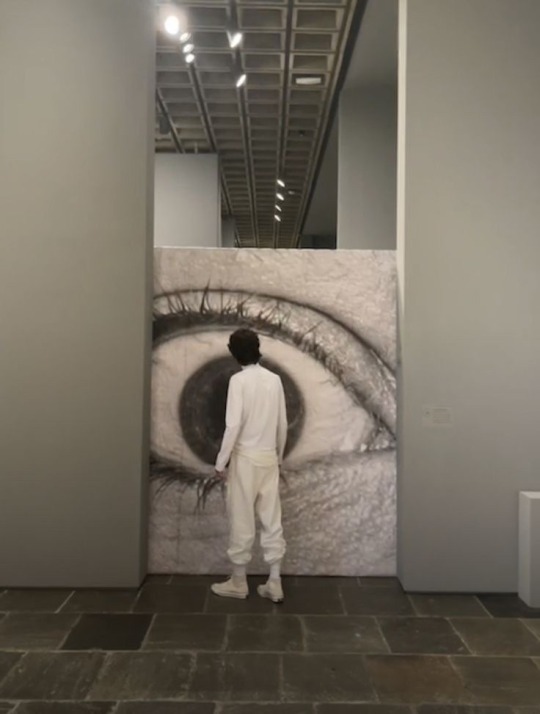

Liked by y/i/n and 2.399.200 others
tchalamet she brought me into her wonderland
tagged: @y/i/n
See all comments
lacma loved having you in our event timothee!
fanpage29 SHUT UPPPPPPPPPPPP IM CRYING OMG
fanpage99 i was in her wonderland too🤨 can we kiss now🧍♀️
pauline.chalamet amazing woman🤩
*Liked by @tchalamet
fanpage44 r u two like…. dating????
maisonalaia impeccable✨
fanpage77 i think this is the first public appearance they made? i remember timmy met her in lacma when she was still interning there
fanpage40 Y/N’S SECOND DRESS IS SOOOO SLAY SERVING QUEEN
y/i/n and in my wonderland you shall stay
↪️ tchalamet no need to tell me twice sweet girl
*Liked by @y/i/n
fanpage39 so its true then? theyre together??
vittoria referring to malice alice i see
↪️ y/i/n shut up vitto
fanpage72 im so happy seeing them together:((( congrats y/n for ur exhibition!
fanpage39 SWEET GIRL FUCK ME RN
@y/i/n tagged @tchalamet in a story!

y/i/n done for today😆
#timothee chalamet#timothee chalamet imagine#paul atreides#paul atreides imagine#instagram au#timothee chalamet imagines#timothee chalamet au#imagine#timothee
119 notes
·
View notes
Text
vimeo
Media Ecology in the Garden
It became apparent as I was heading towards the fourth video in this series that I would need more time to complete the last video. Since I had set the goal of posting a rough cut video artwork every two weeks, instead of giving up or posting a very rushed video work I am posting a video that is a discussion about the topic of art medium and it's shaping of our society.
The work had been planned to explore this subject through a little stop-go story about a man made of chalk who wanted to walk in a 3D world, he was so determined that he discovered how to turn himself into paper and then clay! Once he was able to step foot in the 3D world he wandered through the grass and found a tree. Once he had seen the tree now he wanted to know what it was like to be up in the tree. It was hard work but he was helped with some inspiration from above and he managed to find a way to climb the tree. Now he looked down and saw the chalk garden where he came from. I might still make this work but I am also considering leaving it as artwork in three parts.
These works are part of a larger site specific exhibition in a garden setting. The final show will be a combination of large interactive installations, smaller sound works and the three (or four) video works projected onto various surfaces in the garden.
I hope the video is somewhat engaging and I would love to hear about other opinions on how out society has been shaped, positive or negative by today's technology and mediums.
references
Strate, L. (2008) Studying media as media: McLuhan and the media ecology approach. Media Tropes, 1, 127-142. Retrieved from http://www.mediatropes.com/index.php/Mediatropes/issue/view/174
Fuller, M. (2005). [Introduction]. In Media ecologies (pp. 1-5). Cambridge, Massachusetts: MIT Press.
Shaefer, R, M. (1977) The Tuning of the World. McClelland & Stewart, Toronto, Canada
#anti capitalism#experimental film#female filmmakers#film art#girlartist#videoart#work in process#filmmaking#vimeo#curators#Vimeo
25 notes
·
View notes
Text
The Barton-Salin Colab
Review:
The Salin Installation at Barton’s Bagles: Photography Elevates the Baking Arts
By Cezare Salix
The long-running photography show in Barton’s Bagels (645 San Anselmo, San Anselmo) has been the source of critical debate for nearly two decades. There is no recorded date but we believe the show opened sometime in 2004 with little fanfare.
Why, one might have asked in the early months of the exhibit, would the legendary, somewhat reclusive Barton Goode, bagel impresario continue to display the same set of photographs for so long? Given the artistic value of the work on hand and the apparently haphazard arrangement, the question becomes more compelling.
Early critics who cared to speculate (without the benefit of knowing how long the show would eventually run) made a universal assumption: The artist had talked Barton Goode into storing the work on his walls and that Mr. Goode, famous for his laser-focused commitment to making excellent bagels, agreed and simply forgot the photographs were there. One can picture him entering the darkened shop at 4:00 AM, day after day, year after year to begin his sacred work; he is not thinking about what is on the wall, he is thinking about making the excellent bagels that inspire his audience to line up every morning. This is, after all, a bagel shop not an art gallery.
The installation would not tempt the casual observer think otherwise. It is collection of large, framed photographs by Sierra Salin (an artist also known by a variety of aliases and honorific titles). At first glance, the show is so lacking in a coherent aesthetic that none of the pieces would likely have made it through the first round of judgement at the Lake County Fair. Just as anti-compelling is the apparent absence of care in the works’ arrangement: some are hung in clusters, others more uniformly spaced and a few hidden behind an industrial size refrigerator, tempting the viewer to enter into a space that could intuitively be considered for employees only. (Those who give into that temptation are immediately subjected to nothing noteworthy.)
It is, however, essential to consider the quality of the work before discussing the longevity of the installation, which as we shall see, is the main point the artist is making: Viewed as a whole. it reminds observers of the first time they held a camera. While considering what kind of bagel to order, they may feel a brief spark of joy at remembering the early “discoveries” that children make when they realize the power of the tool: You can take a picture of your toys, you can take a picture of a pretty girl out of context, you can take several pictures of vague reflections in store windows. You can take a close-up picture of someone dressed as a clown. You can adjust settings to create different effects. Of course that joy, at least for those with critical sensibilities is quickly tempered by the understanding that repetitive tropes and intentionally “artistic” constructions are not the same thing as fine art photography. But there is more here than meets the eye and it may well be that Salin is up to something altogether different. His reputation is that of a prankster and his is a talent not to be underrated.
Had the show lasted only a few weeks or even a few months, all would have been dismissed, forgotten, the photos relegated to garage sales where pickers would have scavenged the frames. But a run of a few decades brings the entire nature of the work to the surface and finally has the critical community understanding, as though waking from a recurring dream, that the installation has little if anything to do with photography.
It is closer to a performance piece or a living sculpture, created by Salin, Goode and thousands of unwitting customers who have waited in line over the years. One might be tempted to believe, as earlier critics did, that the phenomenal chronological length of the show is the result of forgetfulness, laziness or Barton’s singular focus on bagels. But the display has run for so long that such an assumption no longer seems viable; the work must be intentional.
The bagels are at least as important as the photography. Barton Goode is a true master of his craft; his creations are the result of decades of training and practice. Like any great artist, he learned from earlier masters, taking jobs at lesser local bakeries, waking up before dawn for years on end, staying focused and finding a method that would bring bagel making to the level of art. Consistency is an enormous part of what he produces. Barton’s bagels never disappoint. One could enjoy his version of the salt bagel or the tomato basil or any other and return years later to find that their excellence intact… and still warm if you get there before 8:00.
While waiting in line for those bagels, patrons have had no choice but to view Salin’s photographs. Like the bagels, the art on the wall has not changed; they have become part of the Barton’s Bagels experience and they add something important to it. The juxtaposition of something delicious, desirable and reliable against something that’s only apparent value is reliability of presence and that provides no other delight than perhaps puzzlement, asks us to consider art as Marcel Duchamp suggested. The Barton-Salin collaboration is similar to Duchamp’s Fountain (1917) in that it asks us to question the very nature of art. But it rises (like a proofing bagel?) to another level. Unlike Duchamp’s overt challenge, consisting of a slightly modified object that no observer would think of as art until it was presented as such, any observer would immediately consider a framed original photo as art regardless of its technical content. If Salin’s work were not just amateurish and bland and were instead hideous, the effect would be lost. After all, who would want to eat a bagel after looking at Goya’s Saturn Devouring his Son (1823) for 15 minutes with your kid in stroller? But these photos are, if anything, unremarkable (outside of their being overtly presented as art for so long.)
This critic contends therefore that the work on the walls inside Barton’s actually enhances the bagel experience by forcing the audience to view reliably present work that generates almost no feeling whatsoever with Barton’s Bagels: works of art that the audience knows in advance will bring delight and appreciation for all that the master bagel maker has put into them.
(The Barton-Salin Photo-Bagel Collaborative will be running at Barton’s Bagels, 645 San Anselmo Avenue through an undetermined date.)
1 note
·
View note
Text
Alexander McQueen - Savage Beauty Exhibition Victoria & Albert
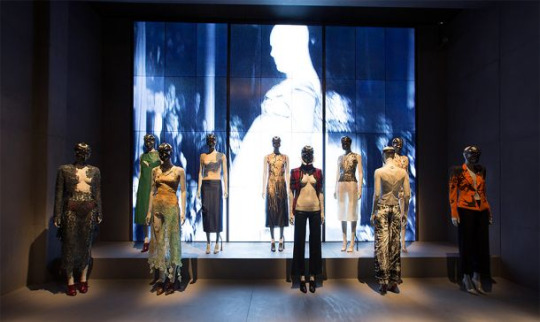
http://www.vam.ac.uk/content/exhibitions/exhibition-alexander-mcqueen-savage-beauty/about-the-exhibition/

http://www.vam.ac.uk/content/exhibitions/exhibition-alexander-mcqueen-savage-beauty/about-the-exhibition/
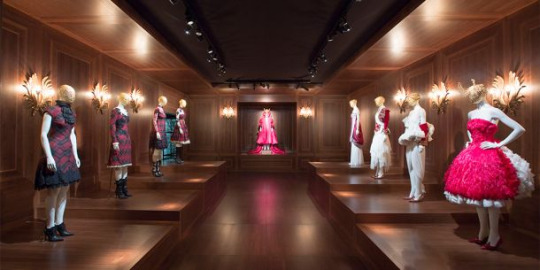
http://www.vam.ac.uk/content/exhibitions/exhibition-alexander-mcqueen-savage-beauty/about-the-exhibition/

http://www.vam.ac.uk/content/exhibitions/exhibition-alexander-mcqueen-savage-beauty/about-the-exhibition/

http://www.vam.ac.uk/content/exhibitions/exhibition-alexander-mcqueen-savage-beauty/about-the-exhibition/
On 14th of March - 2nd August 2015, Alexander McQueen held his Savage Beauty collection at the V&A museum in London. His creativity and originality is fluently expressed through the technical accuracy of his designs. From his spectacular avant-garde ordination installation and art. McQueen boldly challenged the fashion industry, which was a rare sight among designers; McQueen saw potential beyond the physical limitations in the industry.
McQueen left school at 15, becoming a tailor’s apprentice on Savile Row, Mayfair. At the age of 21, 1990, McQueen got accepted to the highly prestigious and reputable MA Fashion course at Central Sint Martins, 3rd best fashion school in the world. Already gaining skills from being an inventive, creative tailor, McQueen learned how to become a fashion designer, withdrawing inspiration from London’s famous history, the world class museums and galleries, and emerging BritArt scene. McQueen began working with a small, closely knit team and very low budget, here he constructed a series of ethereal, captivating and provocative shows, featured in gritty, industrial areas around London. McQueen’s original characteristic, experimented with blends of traditional and subversion was apparent from the beginning with ‘Bumster’ trouser, sharp frock coats, corroded, tarnished fabrics, slashed leather and mangled, flesh-revealing lace. McQueen recollected, ‘There was so much repression in London fashion, It had to be livened up.’
Throughout his extraordinary career, Alexander McQueen regularly reoccurred to the theme of primitivism - ‘ A belief in the value of what is simple and unsophisticated, expressed as a philosophy of life or through art or literature’ - dictionary, drawing upon the fantasy of the virtuous savage living in synthesis with the natural world. McQueen reflected on primitivism frequently, representing it in paradoxical combinations, such as contrasting modern and primitive, civilized and uncivilized. McQueen’s spring/summer 2003 collection, was inspired by the storyline of Irere, which included a shipwreck at sea with many pirates, conquistadors and Amazonian Indians. Often, McQueen’s narrative, honored the state of nature and overturned the moral balance in approval of the ‘natural man’ or ‘nature’s gentlemen’, unrestrained by the artificial establishments of civilization. Thus explained the uniqueness and individuality of his world renowned collections.
2 notes
·
View notes
Video
RGB|CMYK Kinetic from ART+COM on Vimeo.
RGB|CMY Kinetic is a poetic experience of colour, movement and sound. Simultaneously a suspended sculpture and a choreography of light and music, it has roots in two twentieth-century avant-garde traditions: kinetic art and light art. The inspiration for the work stems from the nature of light, particularly from the duality of additive and subtractive colours.
Five flat, disc-shaped mirrors move through space, seemingly floating, illuminated by lights in the three primary colours, red, green and blue (RGB). The discs reflect the light and cast coloured shadows onto the screen on the floor. Where the RGB colours combine, a circle of white light is produced on the floor. This set-up provides the basis for a poetic choreography and the immersive, spatial experience of colourful, synchronised lights and shadows moving in unison with the computative and apparently weightless motion of the discs.
The coloured ellipses on the ground are generated by the three primary colours through addition and subtraction. The mirror discs cast shadows behind them on the ground, and in these shadows the primary-coloured light subtracts into cyan, magenta and yellow (CMY). In front, the discs reflect the RGB light as individual colours onto the ground.
This choreography is complemented by a musical score that unfolds in dialogue with the discs’ movements. The three-part sound composition for RGB|CMY Kinetic was made by Icelandic musician, Ólafur Arnalds. The first part of the composition is based on the movements of the mirror discs: the varying heights of the discs in space modulate the five digital instruments. The following two sections of the composition interpret the computatively designed choreography more freely.
The work draws on earlier kinetic sculptures and reflective kinematronics by ART+COM Studios, and, at the same time, explores the poetic potential of a minimal, yet large-scale, mechatronic installation.
The installation RGB|CMY Kinetic was commissioned by Sónar and the Sorigué Foundation and premiered at SónarPLANTA Barcelona in 2015. Expanded by the dimension of black (the ‘K’ in CMYK stands for key=mask=black), RGB|CMYK Kinetic is a new work produced for the opening exhibition at the Asian Art Center in Gwangju, South Korea. The installations were manufactured and installed by MKT.
1 note
·
View note
Text

Plaza, Yuichi Yokoyama: Not a new translation, but the very newest book from the cacaphony king, published by 888 books, which also handled Yokoyama’s oversized hardcover art & design collection “Fashion and Closed Room” (2015) and the JP edition of his gekiga tome “Iceland” (2016). I did not know Yokoyama had a new book out in Japan until this twitter thread tipped me off - it’s a no-dialogue comic, and the publisher does international direct sales, AND they don’t mind English-language messages from dumb foreigners (or, they didn’t mind me), so dropping them a line would be the easiest way to get it.

This is not “Flower Garden”, the forthcoming third installment of Yokoyama’s gekiga tetralogy; it’s a 264-page large-format softcover, slightly taller than the average “Kramers Ergot”, with the kind of cranked-to-fuck reproduction that allows you discern the texture of the spotted blacks on the page. It won’t make much difference to those I’ve heard from irregularly over the past half of a decade who feel Yokoyama is an all-tricks artist who’s been plowing the same ground to increasingly barren results, but “Plaza” is something of a back to basics piece; while “Iceland” and its predecessor, “World Map Room”, explored slightly plottier interactions between paranoid characters amidst the usual din of life (to say nothing of the intervening gag manga collection “Room”, which I don’t think has yet been published outside of Japan), this new book is like a graphic novel-length version of the most methodical stories from “New Engineering” - activity under a fixed gaze.

But Yokoyama is not the same artist he was in 2004. While his “New Engineering” comics gazed dispassionately upon activities left inscrutable on any level more complex than ascertaining the motion of bodies in combat or the construction of a room — a consequence of the artist creating his stories by drawing forward and backward from key images, avoiding ‘humanism’ so as to escape the impotency of art as personal expression, per him — “Plaza” erects an absolute terror field from the clamor of social joy. Not a single panel of this book is without gigantic sound effects slashing across space with razor edges, COROCOROCOROs and DODODODODOs superimposing themselves atop rolling and marching forms like the reader is gazing through an impossible floating lattice; a prison of noise. And it’s a party on the block!

Apparently inspired by Brazilian carnaval, the action of “Plaza” depicts a massive, unreal stage show, with cheering audience members frequently visible toward the bottom of panels. Banners are unfurled, effigies are raised, rockets ignite, and folkloric skits are enacted. At one point, money is thrown into the crowd like the Joker did “Batman” (1989), though we need not imagine any threat: the roaring crowd is constantly in danger. Enormous trees crash into the audience, they’re nearly chopped by a gigantic swinging blade - at one point a swarm of bees is loosed upon them, yet still they roil in a frenzy as rows of figures stride above them like a martial fashion show-cum-Busby Berkeley dance number roiling with smoke and fire, English titles occasionally superimposed atop the action to demarcate exhibits, but this is not like Yokoyama’s story collections. It’s not like “Travel”, his depiction of a rail journey, and the closest thing he’s had, I guess, to a popular favorite. It takes the sense of specific menace he introduced to his world in “World Map Room” (his best book, along with the majesterial “Color Engineering”), makes that menace integral to the idea of fun, and depicts it as something with no beginning or end. You can read this book starting at any point, which I suppose makes it high formalism, and imagine it never dying, and never being born. Is this Spectacle? Is this the idea Yokoyama has, of life as a fenced rampage of distraction wedding high spirits and mass violence as the unyielding character of existence? The artist stands aloof, but it’s hard to be a god.

23 notes
·
View notes
Text
“Collaboration is Critical to Our Gallery’s Character” - Maggie Kayne and Bill Griffin on the Origins and Evolution of Kayne Griffin Corcoran
By Sarah Evers • September, 2019
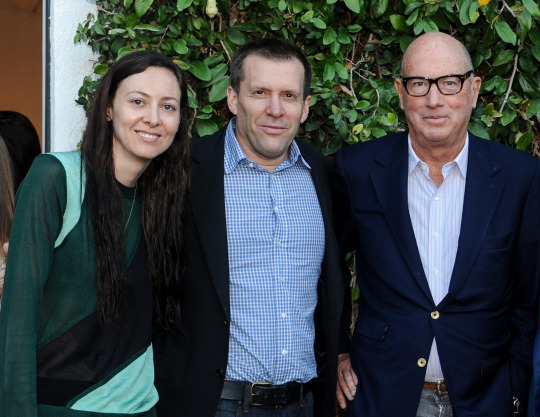
Maggie Kayne, Bill Griffin, James Corcoran. Photo by Stefanie Keenan.
Kayne Griffin Corcoran, a serene refuge off of a busy Los Angeles street, was originally conceived through a meeting of Maggie Kayne, Bill Griffin, and Jim Corcoran to discuss an artist commission and has since emerged as a destination in Los Angeles’s gallery network. Each offering a distinct perspective, the partners of Kayne Griffin Corcoran benefit from each other’s varied experiences, using their differences to foster innovation and constant evolution. A shared commitment to Los Angeles culture and history unites the three partners and acts as the framework from which they have built their roster of internationally-lauded artists and rigorous exhibition programming.
Bill Griffin had previously represented the likes of Southern California icons James Turrell and David Lynch and provides crucial insight on the strategic direction of the business. Jim Corcoran’s long career and extensive art historical knowledge helps to connect the thematic dots between established and contemporary artists. Maggie Kayne approached the art world first as a patron, turning her sights on galleries as a result of the potential of a partnership with Jim and Bill.
We spoke to Maggie and Bill about the partnership’s origins, the character of Los Angeles, and the importance of developing a unique creative vision.

Installation view of “Noboru Takayama,” 2018. Photo by Flying Studio.
When did you become interested in the art world?
Griffin: For me, I was always interested in a visual display of ideas and in learning about ideas through looking at objects. The visual arts was something I gravitated toward as early as elementary school and continued through college. The first exhibition I attended was the King Tut show at the Metropolitan Museum of Art, circa 1978. My mother was a public-school teacher and she somehow got tickets to see the exhibition. I remember waiting in line with her and stepping into the first gallery, crossing that threshold into the Met, and, for me, the world was changed that day.
Kayne: When I moved to New York for college I became friendly with a number of collectors who really opened my eyes up to new ways of seeing and engaging with the art world. I remember discovering this amazing ecosystem of artists, dealers, and collectors, and seeing opportunities to participate in and contribute to this network, not just be a passive observer. From that point on, I realized this was the world I wanted to be in. But it took me some time to find my home in it. I interned at museums, worked at a couple of galleries, spent time with various dealers, and learned all the hard lessons pretty quickly.
How did your careers as art dealers begin, and how does your history compare to where you stand now?
Griffin: In 1994, I borrowed a friend’s pick-up truck, drove to Home Depot, bought some drywall, and rented an old boat warehouse down in Costa Mesa. Twenty-five years later, here I am. I didn’t work for anybody and learned on my own. Working with Jim now for almost two decades has been a huge privilege and has been an incredible way to evolve my eye. Same with a younger partner like Maggie, who is to me incredibly inspiring and authentic in her relationship to art and the art object. I love to be exposed to new things, so every day since that Home Depot visit everything has continued to evolve with breakneck speed and has shaped my involvement in the art world.
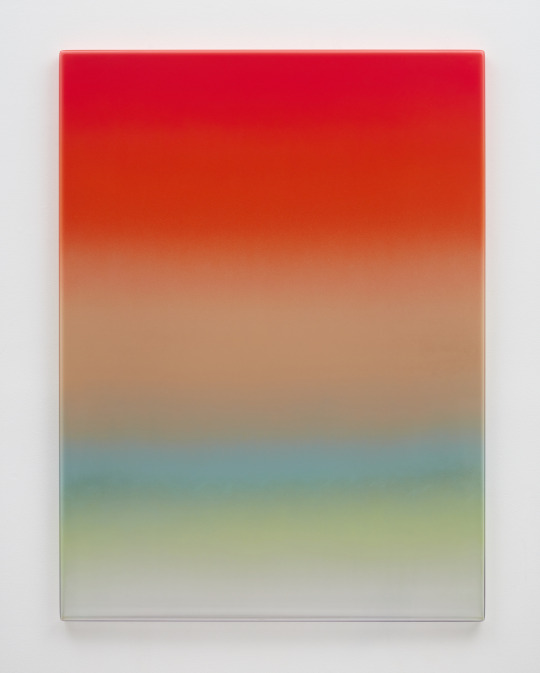
Mika Tajima, Art d'Ameublement (Nukutoa), 2019, spray enamel, thermoformed acrylic. Photo by Flying Studio.
Kayne: As mentioned earlier, I actually started off as a collector which was a really interesting departure point. The idea of opening a gallery didn’t occur to me until much later. In the beginning I just wanted to be around artists and absorb as much as I could. In addition to collecting, I would pick up odd projects here and there. The last thing I was doing before I met Bill was working with Hans Ulrich Obrist producing and filming interviews he conducted at the Venice Architecture Biennale in 2010. I also became very involved with several museums in a philanthropic capacity. I was a founding co-chair of the Hammer Museum’s Hammer Circle Group and a member of LACMA’s Director Circle. This dual identity as a patron/collector on the one hand, and as a dealer on the other, has been complex to navigate at times but has also provided me with a really unique vantage point to understand the diverse needs of artists, collectors, institutions, and many of the other players in the larger ecosystem.
What initiated the partnership amongst the two of you and Jim Corcoran?
Kayne: At this point, I had segued into advising and was working with two clients who were considering a James Turrell Skyspace. This led me to Bill and Jim who represented James here in L.A. I met with them and ended up having a three-hour conversation with Bill. Bill was doing really innovative things with his gallery, both operationally and programmatically, and I was really inspired by the meeting. He then called me two hours later and said “I want to offer you a job and this is what I think you can bring to the table, and this is what I think I can bring to you.” I started working for Bill in January of 2011 and by June we began to explore a more formal partnership. While working with Bill, I also got to know Jim quite well and knew his experience and reputation would be incredibly additive to the partnership. Bill said there was no way that Jim would be on board, but we called him to propose the idea and he said “Sure.” It was totally unplanned and, like anything, was also a function of good timing. Sometimes I laugh because it’s a bit of an odd match but the truth is the three of us have a great rapport, really complementary skill sets, and it just works!

Installation view of “Anthony Hernandez: Screened Pictures,” 2019. Photo by Flying Studio.
Do each of you play specific roles at the gallery?
Griffin: The three of us just naturally respected each other and, like Maggie said, brought different things to the pot. As there is a generational difference of two decades that separate each of us, we have different perspectives on the culture that we live in and recognized this was strategically interesting. We believed in each other’s contributions and visions and just started working together. It has evolved into different things since then, Maggie is in a day-to-day capacity and is very interested in the creative studios and what’s happening out in the world. She’s very active in pursuing those ideas, working in collaborative developments with studios, curators, and other gallerists. I continue to work with a few specific studios, I handle some key client relationships and work on strategically evolving the vision. Jim, as Maggie said, brings his deep network of relationships, and pioneering knowledge of the Southern California art scene.
Kayne: I think if you were to divide it up, my role is definitely more creative. Bill is incredibly strategic and organized. He also appreciates the creative, but he is providing the structure that enables all of us to be successful and to implement our ideas in an effective way. Jim comes in with some crazy and brilliant ideas but also brings deep art historical and institutional knowledge to the table.
Griffin: It’s very unique and rare to find three people that genuinely, as Maggie said, are kind of odd and outliers in different ways, but still come together with a vision and have the ability to execute it.
Kayne: I think we’re also very aligned in our programmatic decisions in that we only work with artists we really believe in, even if the financial upside isn’t immediately apparent. We’re playing the long game and recognize that the market may take a little longer sometimes to verify an artist. We also really enjoy the cross-generational conversation that naturally occurs as a result of the twenty years between each of us.

James Turrell, La Brea Sky, 2013, ©James Turrell. Photo by Flying Studio.
Is there a current through Kayne Griffin Corcoran that unites your three different perspectives?
Griffin: Jim came to Kayne Griffin Corcoran having worked with the studios of legendary artists including Ken Price, John McCracken, and Ed Ruscha, and this focus on the Southern California School is something that is still central to the gallery’s DNA.
Kayne: James Turrell is in many ways the cornerstone of the gallery. The three of us met through a Turrell commission and one of the first shows we did when we opened the gallery was an exhibition about Turrell’s project at the Roden Crater, called Sooner Than Later, Roden Crater. Through our experience selling James’s work, we realized when we got in this space that it would be a lot easier for us to sell holes in ceilings if we had one in our own! To have this Skyspace as the physical and spiritual center of the gallery is incredibly special and was also a game-changer for the business.
Griffin: We had long discussions with him about how to put a Skyspace into a working gallery and it came down to the fact that Skyspaces are places for people to meet and communicate, and that is what a conference room does in a business. Creating this Skyspace inspired James to look at the entire gallery space and address all aspects and we gave him free range to do that. The gallery is located on La Brea Avenue, this cement and tar highway packed with tens of thousands of cars every day racing by and then there’s our gallery, this kind of green oasis. That’s all James.
Kayne: He designed every detail and even mapped out the flow of the space. We brought him in even before the architect, because we knew that he had the ability, more than anyone else, to create a really thoughtful and considered experience. In fact, it was his idea to put a Skyspace in the conference room. He was most excited about creating a gallery space for his peers that had what he refers to as perfect flexible light. He says that he has shown in hundreds of spaces throughout the world and very rarely, if ever, does he see an exhibition space with perfect light.

Installation view of “Beverly Pepper: New Particles From The Sun,” 2019. Photo by Flying Studio.
How do you see the gallery in the larger landscape of the Los Angeles art scene?
Kayne: The vibe of our gallery, both in terms of the programming and the physical space is very much tied to the DNA of Los Angeles. We love this city and are really invested in the cultural community here. This is reflected in the artists we work with, the institutional relationships we cultivate, but also the gallery itself, and even the way the architecture was designed to embrace the particular geographical and cultural differences that make Los Angeles so unique. We’ve got this incredible light, the weather is unbelievable, and being outside is a huge part of the culture here. We’ve really capitalized on this with our courtyard, which we use all the time for outdoor programming and entertaining. I think we’ve also managed to create a really special and refreshing work culture at the gallery which has allowed to us to attract and build an incredibly talented group of professionals.
Griffin: I think our philosophy has developed through our time in L.A. and collaboration is critical to our gallery’s character. We believe in finding good partners globally outside the gallery and fostering productive, long term relationships. I think it helps many galleries know that we are singularly focused and grounded in Los Angeles. Our future is like the past, very organic and open. We know who we are and we look out towards the world but we are very satisfied in the City of Angels. That’s our history. It’s been Maggie’s growing up all her life, mine for the last two decades, Jim’s for his life. That threads through everything that we do and through all of our actions.

James Turrell, Medium Rectangle Glass, 2019, L.E.D. light, etched glass and shallow space. Photo by Flying Studio.
As a newer member to the ADAA, what made you want to join the Association?
Griffin: I think that the ADAA is important as a historical network, but also in the fact that we can all contribute and help it evolve. It makes us better, too. The ADAA’s services affect many elements of our business. I find it to be a wonderful organization to be a part of, and I mean that genuinely.
What significant changes have you seen to the gallery business over the past decade or so?
Griffin: My thought right off the bat is the speed of communication and the speed of how things take place. When I started, we had FedEx and fax machines, and all those things were fast relative to the generation before that. Today, the quickness, the ability to connect and communicate with peers globally, instantaneously and with incredible resources, is remarkable.

Installation view of “Ken Price: Works on Paper 1967-1995,” 2019. Photo by Flying Studio.
Do you have any advice for an aspiring art dealer?
Griffin: Speaking from a dealer’s standpoint, my advice would be don’t follow the market. Create a unique vision, support your artists, work hard, and success will follow.
Do you have any advice for a budding collector?
Kayne: The eye is a muscle and needs to be exercised–and not just online! Show up at gallery openings, visit museums, attend art fairs, and make an effort to see things in person. And buy with your eyes and your gut, not with your ears.
*All images courtesy the artists and Kayne Griffin Corcoran, Los Angeles.
1 note
·
View note